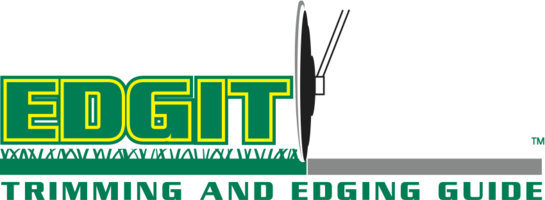“FOLLOWING THE EDGE”
“A Lawn Manicuring System”
The following are some procedures and observations on what we believe to be the best methods of handling straight shaft trimmers.
1) Most straight shaft trimmers spin their string counter clockwise. As a result, when these trimmers are used to trim against a wall, they cut through the grass much more cleanly and efficiently when moved along said wall from right to left. This forces most right handed operators to either twist their upper body toward the wall or walk sideways or backwards while trimming clockwise around a building.
2) The more efficient and safer way to trim from right to left is to trim left handed. [Left hand on throttle, right hand on handle.] This allows the operator to walk straight ahead (instead of sideways or backwards) with his right shoulder closest to the wall and holding the trimmer across his waist with his arms fully extended. This method substantially reduces fatigue.
And if you train new operators this way from the beginning, it’s easy. Even experienced operators can “follow the edge”, even if they continue to edge and trim right-handed. However it’s still much more productive when the trimmer is operated left-handed.
3) For example: When the EDGIT™ is used to edge left handed (throttle in the left hand), it is the right side of a sidewalk that is edged most efficiently (with the operator standing on a sidewalk edging in front of himself). This is especially true of lawns that do not already have an established groove between the lawn and pavement or are not edged every mowing. This phenomenon is also due to the rotation of the string. (Tip = try pulling the EDGIT behind you instead of pushing it like a walk-behind edger. This really works great.)

HOW TO “FOLLOW THE EDGE”
For the purposes of training; curbs, sidewalks, driveways, mulched beds (those against the building) and the building itself;constitute "the edge". Once the operator starts on an “edge” he follows it with an eye toward trimming anything along the way.... then immediately returns to the “edge” and continues following these interconnected edges.
Remember, “the edge” constitutes a kind of continuous, unbroken path, (kind of like a yellow brick road) which leads the operator around a property to each of his assorted duties. This “manicuring system” eliminates the need for the operator to be familiar with the property layout in order to avoid missing anything.
[There are, however, instances where the operator may be required to edge right handed because of obstacles. An example would be cars blocking the operator’s path along a curb, in which case, the operator can simply switch hands and step out onto the lawn and continue edging this way until past the obstacles. Being able to trim and edge, both right and left handed, increases an operators versatility and can often eliminate backtracking, which is the cardinal sin against productivity.]
Once you understand the logic behind “Following the Edge”, its underlying simplicity becomes clear. This manicuring system will faithfully lead any trimmer operator about almost any property in the most productive manner possible. At the same time they will be doing a better job of trimming and producing distinctive vertical edges.
The following illustrations are a general guide that demonstrates the most efficient method for manicuring properties.
Good luck.

